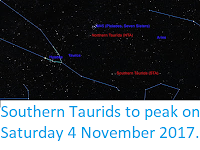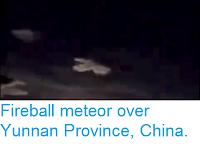Researchers from the University of Calgary have found a number of fragments of meteorite believed to have come from an object that entered the atmosphere over British Colombia on 29 September 2017. The object entered the atmosphere roughly above the town of Boswell and exploded
in
an airburst (an explosion caused by superheating from friction with the
Earth's atmosphere, which is greater than that caused by simply
falling, due to the orbital momentum of the asteroid) close to Meadow
Creek., a distance of about 100 km. The meteor is described as initially
burning green, then orange, with people close to the termination point
reporting a loud explosion. Following a search a number of fragments of rock believed to have come from the object have been found on private land near Crawford Bay, roughly 30 km to the south of Meadow Creek.
Fragment of meteorite found near Crawford Bay, British Columbia, and thought to have come from the 29 September 2017 meteor. Surrey Now-Leader.
A fireball
is defined
as a meteor
(shooting star) brighter than the
planet Venus. These are typically caused by pieces of rock burning up in
the atmosphere, but can be the result of man-made space-junk burning up
on re-entry.
Fireball meteor near Nelson in British Colombia on 4 September 2017. Rafael Pern/Twitter.
Objects
of this size probably enter the Earth's atmosphere several times a
year, though unless they do so over populated areas they are unlikely to
be noticed. They are officially described as fireballs if they produce a
light brighter than the planet Venus. The brightness of a meteor is caused by friction with
the Earth's atmosphere, which is typically far greater than that caused
by simple falling, due to the initial trajectory of the object. Such
objects typically eventually explode in an airburst called by the
friction, causing them to vanish as an luminous object. However this is
not the end of the story as such explosions result in the production of a
number of smaller objects, which fall to the ground under the influence
of gravity (which does not cause the luminescence associated with
friction-induced heating).
These 'dark objects' do not continue along the path
of the original bolide, but neither do they fall directly to the ground,
but rather follow a course determined by the atmospheric currents
(winds) through which the objects pass. Scientists are able to calculate potential trajectories for hypothetical dark
objects derived from meteors using data from weather monitoring services.
See also...
Follow Sciency Thoughts on Facebook.








